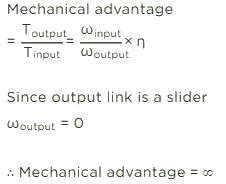GATE Past Year Questions: Slider - Crank Mechanism | Theory of Machines (TOM) - Mechanical Engineering PDF Download
Q1:The figure shows a wheel rolling without slipping on a horizontal plane with angular velocity ω1 A rigid bar PQ is pinned to the wheel at P while the end Q slides on the floor. What is the angular velocity ω1 of the bar PQ? (2023)

(a) ω2 =2ω1.
(b) ω2 = ω1.
(c) ω2 = 0.5 ω1
(d) ) ω2 = 0.25 ω1
Ans:(d)
Sol:
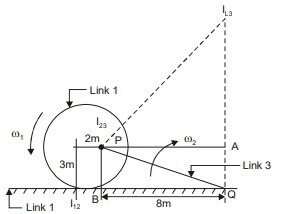
As Disc (Link 2) roll without slipping on Link 1 (surface) so their I-centre of rotation lies on point of contact to avoid relative motion in between them. So I12. lies on point of contact. Link 2 and 3 have instantaneous center of rotation at I 13 due to fixed surface of Link 1.
As per point Plies on link 2 and 3 both so, point P has same velocity for Link 2 and 3 both.
As per Kennedy's theorem, if three plane bodies have relative motion among themselves, their I-centre must lie on a straight line.

Q2: The Whitworth quick return mechanism is shown in the figure with link lengths as follows: OP = 300 mm, OA = 150 mm, AR = 160 mm, RS = 450 mm. (2021 Set 1)
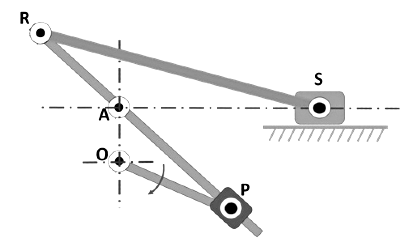
The quick return ratio for the mechanism is ________(round off to one decimal place).
(a) 1
(b) 2
(c) 2.5
(d) 3.5
Ans:( 2)
Sol:
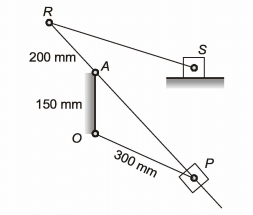
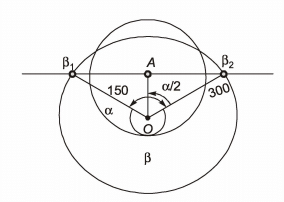
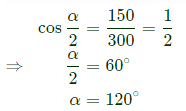

Q3: The crank of a slider-crank mechanism rotates counter-clockwise (CCW) with a constant angular velocity ω, as shown. Assume the length of the crank to be r. (2019 Set2 )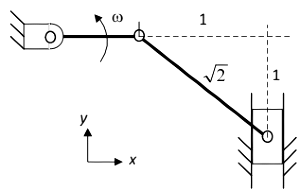
Using exact analysis, the acceleration of the slider in the y direction, at the instant shown, where the crank is parallel to x-axis, is given by
(a) -ω2r
(b) 2ω2r
(c) ω2r
(d) -2ω2r
Ans:(c)
Sol:
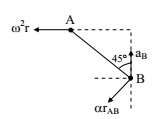



Q4:A slider crank mechanism is shown in the figure. At some instant, the crank angle is 45 ∘ and a force of 40 N is acting towards the left on the slider. The length of the crank is 30 mm and the connecting rod is 70 mm. .Ignoring the effect of gravity, friction and inertial forces, ,the magnitude of the crankshaft torque (in Nm) needed to keep the mechanism in equilibrium is _________ (correct to two decimal places). (2018 Set1)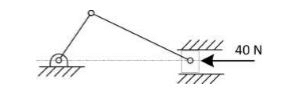
(a) 0.12
(b) 0.56
(c) 1.12
(d) 2.52
Ans:(c)
Sol:

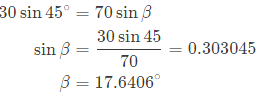

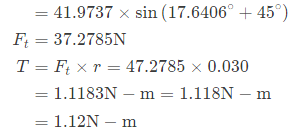
Q5: In a certain slider-crank mechanism, lengths of crank and connecting rod are equal. If the crank rotates with a uniform angular speed of 14 rad/s and the crank length is 300 mm, the maximum acceleration of the slider (in m/s 2 ) in__________ (2015 Set 2)
(a) 117.6m/s
(b) 215.4m/s
(c) 125.2m/s
(d) 458.6m/s
Ans:(a)
Sol:


Q6: A slider-crank mechanism with crank radius 60 mm and connecting rod length 240 mm is shown in figure. The crank is rotating with a uniform angular speed of 10 rad/s, counter clockwise. For the given configuration, the speed (in m/s) of the slider is _______ (2014Set 3) 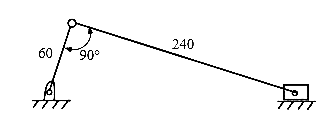
(a) 0.2m/s
(b) 0.9m/s
(c) 0.6m/s
(d) 9.5m/s
Ans:(c)
Sol:
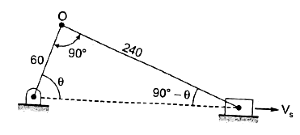

From the given configuration,
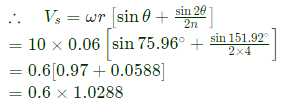

Q7: An offset slider-crank mechanism is shown in the figure at an instant. Conventionally, the Quick Return Ratio (QRR) is considered to be greater than one. The value of QRR is _______ (2014 Set 1)
(a) 1.25
(b) 2.15
(c) 3.25
(d) 4.51
Ans: (a)
Sol:
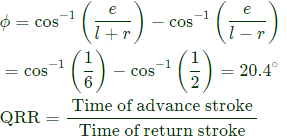
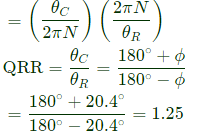
Q8: A slider crank mechanism has slider mass of 10 kg, stroke of 0.2 m and rotates with a uniform angular velocity of 10 rad/s. The primary inertia forces of the slider are partially balanced by a revolving mass of 6 kg at the crank, placed at a distance equal to crank radius. Neglect the mass of connecting rod and crank. When the crank angle (with respect to slider axis) is 30 o the unbalanced force (in newton) normal to the slider axis is _______ (2014 Set 1)
(a)30N
(b) 20N
(c) 10N
(d) 40N
Ans: (a)
Sol :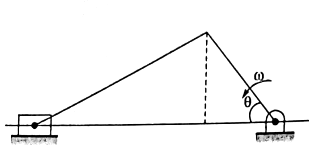
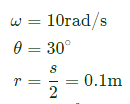

Q9: For a four-bar linkage in toggle position, the value of mechanical advantage is: (2006)
(a)0
(b) 0.5
(c) 1
(d)∞
Ans: (b)
Sol:
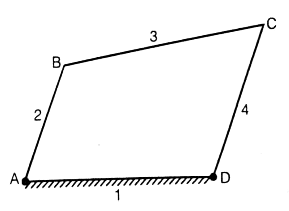
ω 4 of the output link DC becomes zero at the extreme positions. The extreme positions of the linkage are known as "Toggle position".
Q10: For a mechanism shown below, the mechanical advantage for the given configuration is (2004)
(a)0
(b) 0.5
(c) 1
(d)∞
Ans: (d)
Sol:
Mechanical advantage
since output link is a slider
Hence,𝜔 output =0
∴ Mechanical advantage =∞
[2004]
[1998]
[1997]
|
87 videos|76 docs|29 tests
|
FAQs on GATE Past Year Questions: Slider - Crank Mechanism - Theory of Machines (TOM) - Mechanical Engineering
| 1. What is a slider-crank mechanism in mechanical engineering? |  |
| 2. How is the displacement of the slider calculated in a slider-crank mechanism? |  |
| 3. What are the applications of a slider-crank mechanism? |  |
| 4. How does a slider-crank mechanism differ from a four-bar linkage mechanism? |  |
| 5. What are the advantages of using a slider-crank mechanism in mechanical systems? |  |

